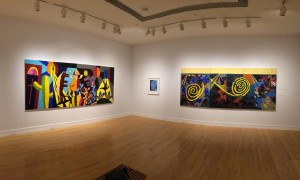You’ll see vibrant evidence of a painter maturing and developing in “Russ Warren: Works 1971-2015,” a 44-year survey of the longtime Davidson College art professor’s career. It’s now on view at the college’s Van Every/Smith galleries.
Warren, born in Houston in 1951, grew up surrounded by art, from Picasso to Mexican muralist Rufino Tamayo, and says he’s always been inspired by Mexican masks, “Day of the Dead” folk art and colonial paintings – especially in their disinterest in realism. A student of art history generally, he’s been more recently influenced by Roy de Forest, fellow Texan James Surls and Chicago Imagist painter Roger Brown.
“Works” is presented chronologically and includes works on paper and a lone sculpture, though paintings predominate.
Early paintings such as “Still Life with Hands” (1971), “Texas Businessman” (1973), and “Rodeo” (1975) illustrate his formative period: Here are a Cubist-like collaged still life and a primitivist male figure followed by a prototypical rendition of the American West cowboy rodeo. They show his preference for essential form, relying on composition and the proximity of his subjects for animation.
In 1980’s “The Temptation,” a primitively rendered male and dog stand over a bright crimson mask. The artist magnifies this ambiguous drama with a spiraling matrix of frosty blue and lime green brush marks. Warren’s directness, unself-conscious painterly approach and edgy brushed surfaces create the sense that he has chiseled space and form from the eternal darkness.
In 1984, Warren was selected by New York’s New Museum Director Marcia Tucker to be part of that year’s American entry to the prestigious Venice Biennale, an international art exhibition.
The painting “Burial at Barrio San Antonio,” made two years later, show mature and commanding abilities. In a nod to Spaniard Francisco Goya, stark purgatorial and landscape spaces are infused with exquisitely modulated passages of color. The work both exhumes and reburies Goya: Angels and demons are shown clutching the artist’s skull, suggesting a struggle between good and evil. On the right, a shaft of golden light beckons as angels appear to ascend with the deceased’s remains towards the heavens. Where Goya’s skull is, in fact, isn’t known. He was buried in France in 1828 and, when exhumed to be returned to Spain decades later, his head was reported gone.
In “Burial at Barrio San Antonio” we see a maturity in technique many struggle to achieve and never do. Warren’s experimentation with acrylic media enabled him to realize the rich, textured appearance of oil-painted surfaces. Softened and modulated form, atmospheric effects and lushly textured surfaces create an otherworldly feel.
More recently, Warren has begun using multiple panels. His compositions and narratives are increasingly complicated, and show off his versatility with the brush and his love of vivid, pulsing color ranges.
Compare “La Infanta II” (2014) and “Night Fishing at Mom’s” (2015).
The first is an inspired reprise of Diego Velásquez’s 1656 tour de force painting “Las Meninas”; the second recalls an intimate family experience. In each, Warren uses plunging diagonals to create drama, and plays broad expanses of color off the intricacies of natural settings. He also creates repetitious forms in each: undulating bulbous cacti, and the whites of the teeth of fish.
“Russ Warren: Works 1971-2015” is a must-see exhibition. The paintings are playful, sometimes haunting and ripe with imaginative intrigue. The stories Warren paints are memorable. But it’s his artistic range and wizardry with the brush and with color that bring them to life.
Image: La Infanta II (left; 2014, acrylic on canvas, 4 panels, 60 x 32” each) and Night Fishing at Mom’s (2015; acrylic, fishing line, fish hooks on canvas; 3 panels, 60 x 48 inches each). Courtesy of Les Yeux du Monde; photo by Mark Leach.
Read the original article from the Charlotte Observer here.

